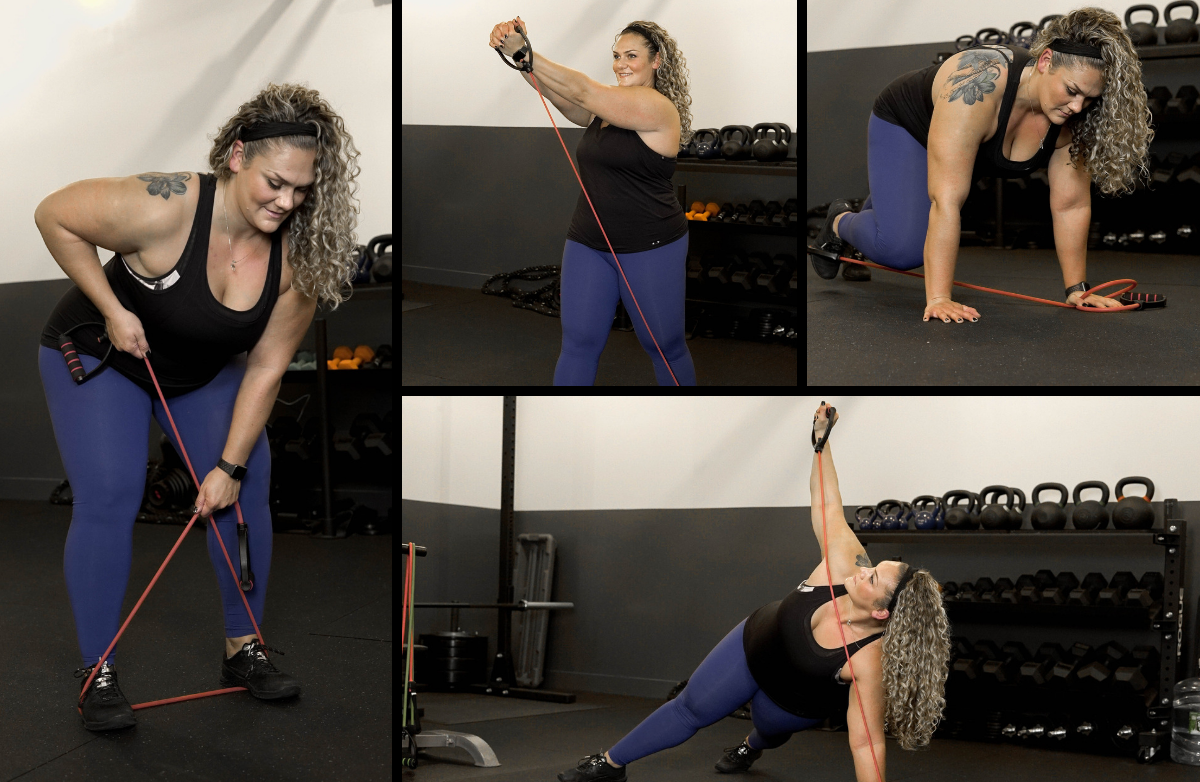Keep in mind that the terms pull-up and chin-up are often used interchangeably. Using an overhand (palms facing away) grip relies heavily on back strength, which includes the latissimus dorsi and trapezius muscles; the underhand grip (palms facing you) grip relies more on the biceps. Both exercises also require significant core and lower body strength to assist in stabilization of the body during the movements. By incorporating exercises that target these muscles into your regular strength routine, you'll impress yourself and your peers by pumping out pull-ups in no time.
Step One: Strengthen the Targeted Muscles
Add these five exercises to your routine two to three days per week for the next eight weeks. Perform each exercise for one to three sets, eight to 12 repetitions per set.
Seated Dumbbell Rows
Muscles worked: upper back, biceps, shoulders
Sit at the edge of a chair with your legs together and back straight. Hinge from the hips to lower the torso onto the thighs. Hold weights near the floor with the palms facing the body and the arms extended directly below the shoulders. Squeeze shoulder blades together and bend elbows to about 90 degrees to lift weights away from the floor. Slowly return weights to starting position by straightening arms back down.
Biceps Curls
Muscles worked: biceps
Stand with feet hip-distance apart, knees slightly bent and abs tight. Lock elbows into the side of your torso and rest weights in your hand on the front of the thighs. Curl one dumbbell up to your shoulder, lower to starting position slowly, then curl the dumbbell in your opposite hand up and back down to complete one rep.
Banana
Muscles worked: abs, shoulders
Lie on the floor with legs together, arms extended overhead and the belly button pulled in toward the spine. Keeping the head between the arms, slowly raise the upper body and legs off the floor to form a gentle curve with the spine. Hold for 20 to 30 seconds, or as long as you can with proper form. Repeat two to three times, gradually increasing the duration of the hold or number of reps as you get stronger.
Dumbbell Squat with Overhead Press
Muscles worked: quads, glutes, core, shoulders
Stand with feet hip-width distance apart with the toes pointing forward. Hold dumbbells in front of shoulders with elbows bent and palms facing outward. Bend knees and hinge from the hips to squat down, keeping your chest lifted and back straight. Straighten legs to return to the starting position, then press weights overhead in line with shoulders to straighten but not lock the arms. Slowly lower weights back down in front of shoulders to complete one rep.
Hanging Hold
Muscles worked: shoulders, core
Begin standing on a box and holding the pull-up bar with an overhand grip. Step off the box and think about pulling the ribs and hips closer together as you hang suspended in the air. Keep the lower back flat and feet slightly out in front of the body. Squeeze the shoulder blades together and hold this position for 20 to 30 seconds, or as long as you can hold with proper form. Repeat two to three times, gradually increasing the duration of the hold or number of reps as you get stronger.
Step Two: Practice Makes Perfect
Once you've perfected the exercises that strengthen your pull-up muscles, it's time for the next challenge: proper form and practice.
If you have access to a pull-up bar and someone to help, ask them to hold your legs and give assistance as you lift your body to the top position. As much as possible, try to lower yourself down without help. Always use good form by grabbing the bar at shoulder-width, crossing your feet at the ankles and bending your knees so that your feet are off the ground. Over time, the helper should provide less assistance so that, eventually, you're performing the pull-up completely with your own strength.
If you don't have someone to help, you can still gradually progress on your own. Stand on a box at a height that allows you to grab the pull-up bar and take a small jump into the "up" position. Lower yourself down as slowly as possible to help strengthen the muscles needed to eventually pull you up.
Try adding one to three sets of either of these exercises to your regular strength routine, in addition to your targeted pull-up strength moves. Start with as many repetitions as you can, slowly building up to eight to 12 in each set. Once you feel comfortable and strong, you'll be ready to tackle the unassisted version!
Additional reporting by Nicole Nichols.




.png)
.png)


.jpg)


.jpg)
.jpg)
